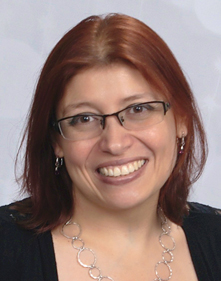by Tasmiah Akter
Wesleyan faculty’s collective expertise spans the globe, and the Office for Intercultural Learning
at the Fries Center for Global Studies is pleased to celebrate their international and often
multilingual work here in the Wes and the World newsletter. This is the last part of the four part
series where we spent time highlighting different topics in the last few weeks: World Literature,
Economics & Environment, Identity: Cultural & Religious, and STEM & Health. Please enjoy
these summaries and be sure to check out any works that pique your interest!
Teresita Padilla-Benavides

MB&B
Region of Study – N/A
Work Title(s): “Differential Contributions of mSWI/SNF Chromatin
Remodeler Sub-Families to Myoblast Differentiation”; “Functional effect
of indole-3 carbinol in the viability and invasive properties of cultured
cancer cells”;“Single nucleotide polymorphisms and Zn transport by ZIP11
shape functional phenotypes of HeLa cells”
Link to article 1: https://www.mdpi.com/1422-0067/24/14/11256
Link to article 2:
https://academic.oup.com/metallomics/article-abstract/16/2/mfae006/7591316?redirectedFrom=f
ulltext&login=false
Link to article 3:
https://www.sciencedirect.com/science/article/pii/S2405580823000730?via%3Dihub
Our recent work described special enzymes in our bodies called mSWI/SNF complexes that help
cells do their jobs properly (https://doi.org/10.3390/ijms241411256). These enzymes are like
little machines that use energy to rearrange the DNA in our cells, which is really important for
cells to function normally. We described that these enzymes come in different complexes, named
BAF, ncBAF, and PBAF. Each type has its own unique set of parts, called subunit proteins. In
this study we wanted to understand what each flavor of enzyme does in the process of turning
immature muscle cells (myoblasts) into mature muscle cells. To figure this out, they played
around with the genes responsible for making the unique parts of each type of enzyme. We found
that one specific part, called Baf250A, from the BAF complex it belongs to, was important for
turning on the genes that make muscle cells act like muscle cells. Another part, Brd9, and its
related complex (ncBAF), didn’t directly control muscle cell genes but still played a role in
helping them to be muscle cells. The third part they looked at, Baf180, from PBAF complex,
didn’t seem to be that important for this process. So, basically, we figured out which parts of
these enzyme machines are crucial for making muscle cells correctly.
We also study how metals, and some natural compounds help to attack cancer cells in vitro. For instance, the metal zinc (Zn) is a very important nutrient that helps enzymes work, controls how genes are expressed, and sends signals within cells. When the levels of Zn ions get messed up in cells, it can lead to diseases. There is a special protein called ZIP11 that helps keep Zn levels balanced in cells. This protein is mostly in the nucleus (the control center of the cell) and the Golgi apparatus (a cellular ‘post office’). We found that ZIP11 is particularly important for controlling Zn levels in cervical cancer cells (https://doi.org/10.1093/mtomcs/mfae006). We looked at data from cervical and ovarian cancer patients and noticed that some specific changes in the gene that makes ZIP11, called SLC39A11, correlated with how severe the diseases were.
We proposed that these changes might affect how well ZIP11 works by altering how it interacts with its targets. To test this idea, we made cells with these genetic changes and studied how they behaved. We found that some versions of ZIP11 with these changes were able to rescue Zn levels and certain cancer-like behaviors in cells lacking normal ZIP11. On the other hand, we found that messing with a key part of ZIP11 that binds to metals made cells behave like they had low levels of ZIP11. So, these findings suggested that Zn plays a really complex role in how cells work, especially in cancer, and that proteins like ZIP11 could be targets for new treatments. Other line of research in our lab seeks into natural products as supplementary treatments to normal therapies, against cancer.
When treating cancer, doctors often use different methods like surgery, radiation, and chemotherapy to get rid of tumors. But chemotherapy can have unpleasant side effects, so researchers are always looking for new drugs to help ease these effects. Natural substances found in plants and other sources are being explored as potential options. One of these natural substances is called indole-3-carbinol (I3C), which acts as an antioxidant. It’s been studied for its possible benefits in treating cancer. I3C works by activating something called the aryl hydrocarbon receptor (AhR), which is a protein that helps control the activity of certain genes involved in various processes including development, immunity, sleep-wake cycles, and cancer. In this work, we looked at how I3C affects the behavior of liver, breast, and cervical
cancer cells. We found that when these cancer cells were treated with I3C, they weren’t as good
at growing, moving around, or invading other tissues. Additionally, I3C caused changes in the
mitochondria, which are the powerhouses of cells. Based on these findings, we proposed that I3C
could be a useful addition or supplement to existing cancer treatments, potentially helping to
slow down the growth and spread of cancer cells in various types of cancer.

However, many studies in animals and clinical trials needs to be done to before this compound can be used by patients (https://doi.org/10.1016/j.bbrep.2023.101492).
To find out more of our current research and new of our students please visit:
Katja Kolcio

Dance, Environmental Studies, REES
Region of Study – Ukraine
Work Title(s): “Force of Breath: Somatic Practices for Psycho-Social
Health”
The Force of Breath somatic program was developed by Katja Kolcio and her partners in Ukrainian grassroots organization Development Project between 2014 and 2019. It was implemented and assessed in Donbas with support from the UN and Wesleyan University. The program was published by Volyn University in 2022, and an English language version is currently under contract. The program has been implemented by the National Guard and is incorporated into psycho-social and psychology programs in higher education in Ukraine.


